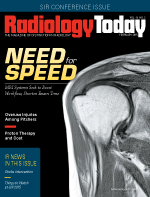 February 2015
February 2015
Imaging Informatics: Improving Workflow
By David Yeager
Radiology Today
Vol. 16 No. 2 P. 6
Managing workflow is one of the biggest challenges in modern medical care, especially for radiology. The image volume, variety of modalities, and need for rapid turnarounds on radiology reports make every second important. Unfortunately, tools for efficiently managing medical workflow are far behind those used in other industries.
At RSNA 2014, Bradley J. Erickson, MD, PhD, a radiologist at Mayo Clinic, talked about ways to improve workflow, not only within radiology departments but also in larger care networks. A workflow engine has the potential to streamline work moving through the radiology department. According to Erickson, workflow engines, unlike many other available workflow tools, can take advantage of features used in other fields to significantly improve the quality and efficiency of radiology service.
"It's an interesting technology that's had relatively little publicity or use within the medical field," Erickson says. "I'm not sure that anybody is using an actual workflow engine in radiology. Some companies have built interpreters for rules, but those products don't provide the same functionality as a real workflow engine."
Mayo has adapted Activiti, a free, open-source workflow engine that's commonly used in manufacturing, to manage radiology workflow. Erickson says the workflow engine offers features that aren't available with other products. For example, if it goes down in the middle of a task, it can pick up where it left off when it restarts. It also has a timer function that allows the radiology department to assign time limits for specific tasks. If a particular task takes too long, the workflow engine can execute an error workflow to work around it.
Another benefit is that departments can specify rules to direct workflow. Although many workflow engine tools allow users to create text files of simple rules, Erickson says the best workflow engines have significantly more capability, including the ability to draw workflows and then click a button to deploy them. Erickson says diagrams provide a more accurate representation of workflow because they allow users to visually depict workflows, rather than simply describe them with text, which makes maintenance easier, especially as rules become increasingly complex. It also allows users to get a better sense of whether a proposed workflow process is viable. Mayo has used this capability to build an interface that reads DICOM and HL7 so that they can implement workflow rules based on the properties of medical images.
"For instance, with a post-CAD [computer-aided detection] image of the head, you can write a rule that takes the post-CAD images and aligns them [with the original image] then subtracts them so that you can see what the difference in enhancements is," says Erickson.
Speaking the Language
Erickson says standardizing terminology plays an important role in workflow efficiency. He says there are certain key processes that occur across radiology delivery, but there is wide variation in how those processes are structured. Standard terminology would allow processes to be compared within or across institutions.
"For example, if our radiology report turnaround time is 32 minutes, that may be a better performance than another institution whose turnaround time is 25 minutes," Erickson says. "And the reason is that each institution may define turnaround time in slightly different ways. By having an agreed-upon, codified set of events and definitions of performance metrics, in terms of those events, now everybody is speaking the same language. I think that getting agreement on the terminology—the lexicon—is a critical piece to really understanding and improving workflow."
When terms are standardized, it's possible to look at the sequencing of events and optimize performance. Erickson says Mayo has found significant variation in sequencing among different facilities within the organization, but it wasn't immediately apparent because the facilities were using different terminology and definitions. Another area where a workflow lexicon is essential, he adds, is in implementing radiology dashboards.
Erickson has worked extensively on a workflow lexicon that was sponsored by SIIM and later adopted as part of RSNA's RadLex initiative. He has appealed to Integrating the Healthcare Enterprise members to adopt ways to use the workflow lexicon because he sees it as an infrastructure issue, rather than strictly a radiology issue, but, so far, he's found a more receptive audience in radiology.
The biggest challenge with the lexicon, however, has been getting vendors to adopt it. Although there has been some movement among vendors toward adoption, it has been slow. Erickson says that is because most of the events that the workflow lexicon describes are located in the RIS and the RIS market is mature, it seems likely that adoption will continue at a slow, steady pace.
"When I talk with the vendors, they don't have any problem with the concept, and I would say they agree with it. The challenge is that this is really in the fabric of their product and so to instantly adopt it all would mean a substantial rewrite of their product, the RIS and the PACS," Erickson says. "So I'm guessing that this will be a slow, incremental process, where they pick off five or 10 of the most important events and implement that in the next release. And then the following release will have another five or 10 and, over time, there will be an adoption of more and more of the lexicon terms within products."
— David Yeager is a freelance writer and editor in southeastern Pennsylvania. He writes primarily about IT topics for Radiology Today.

